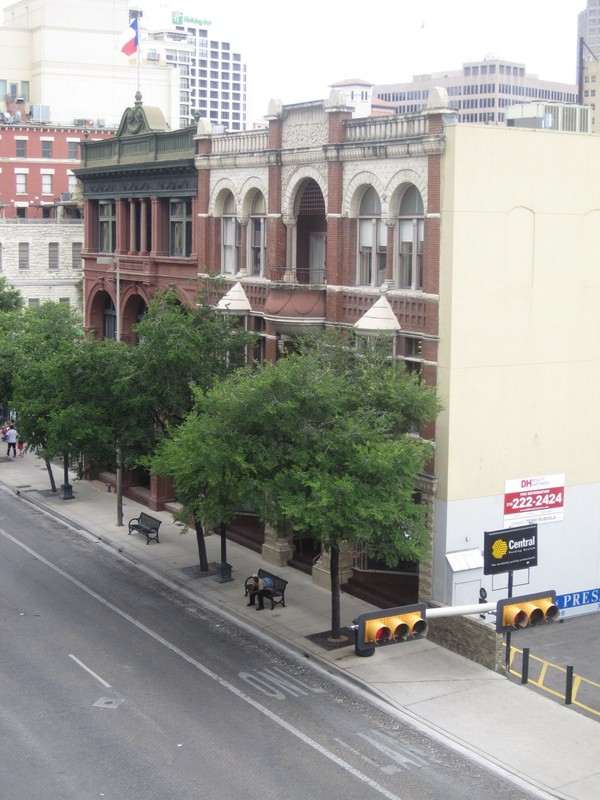Staacke Brothers and Stevens Buildings
Introduction
Text-to-speech Audio
Designed by prominent Texas architect James Riely Gordon (1864-1937), the Staacke Brothers and Stevens Buildings are historically significant as fine examples of late 19th century commercial architecture and represent the economic growth and prosperity the city was experiencing at the time. German immigrant Augustus Staacke (1825-1909) built the Staacke Building in 1894 to house his general merchandising business whose products included carriages, buggies, and Studebaker wagons. Gordon designed the building in the Renaissance Revival style. It stands on the site of First Presbyterian Church in San Antonio, an adobe structure built in 1846. Local businessman John J. Stevens (1852-1928) erected the Stevens Building in 1891. It housed his office and Stevens rented out the remaining space to businesses. Gordon designed it the Richardsonian Romanesque style. Both buildings are listed on the National Register of Historic Places and house offices and businesses today.
Images
The Stevens Building (right) and the Staacke Building (left) were built in 1891 and 1894, respectively. They represent late 19th century commercial architecture in San Antonio whose purpose was to give buildings a distinctive appearance to the public.

Backstory and Context
Text-to-speech Audio
Staacke Building
Augustus Staacke was born in Hanover, Germany in 1825. When he immigrated to the United States is unclear but it appears he and his family arrived in San Antonio by the late 1860s. In 1869, he bought the property and whether the adobe church was still standing at the time is unknown. He built a stone structure to house his business, which eventually expanded to include carriages and wagons. He sold it to his three sons in 1889, who renamed it Staacke Bros. The present building was constructed in 1894; the previous structure was not completely torn down, however, as parts were incorporated into the new building. The company owned other buildings as well, including a warehouse across the street. In 1905, it introduced the first automobile to San Antonio. Eventually, the company transitioned to selling only automobiles and sold the building in 1924 to move to a new location. In the coming decades, a paint company and furniture company occupied the building. It was restored in the 1980s.
Stevens Building
John J. Stevens was born in San Antonio to Irish parents in 1852. His career began when he became the private secretary of Governor Edmund Jackson Davis in 1870. He later became the chief clerk of the Southern Pacific Railroad in Galveston, Texas. He managed a hotel known for its mineral baths between 1900 and 1904. Over the years, Stevens invested in a number of ventures and served on a number of boards such as the Turner Gravel Company, the Southern National Gas Company, and the City National Bank. He was also involved in real estate.
A business called the Wagner and Chabot Company occupied the Stevens Building for 45 years. A furniture company (not the same that occupied the Staacke Building) was housed here between 1946 to 1979. The University of San Antonio occupied the third floor for nearly 60 years. In 1979, Nix Hospital bought the building with the intent to demolish it to make room for a parking lot. Fortunately, it was saved thanks to the efforts of the San Antonio Conservation Society and restored.
Sources
Goodman, Elizabeth A. "Stevens Building." National Park Service - National Register of Historic Places Nomination Form. May 10, 1984. https://atlas.thc.texas.gov/NR/pdfs/84001614/84001614.pdf.
Bobbitt, Lynn O. "Staacke Brothers Building." National Park Service - National Register of Historic Places Nomination Form. September 9, 1980. https://s3.amazonaws.com/NARAprodstorage/opastorage/live/63/9711/40971163/content/electronic-records/rg-079/NPS_TX/80004079.pdf.
"History." First Presbyterian Church of San Antonio. Accessed March 21, 2023. https://fpcsanantonio.org/about/history.
Wikimedia Commons: https://commons.wikimedia.org/wiki/File:Staake_Stevens_Buildings.jpg
